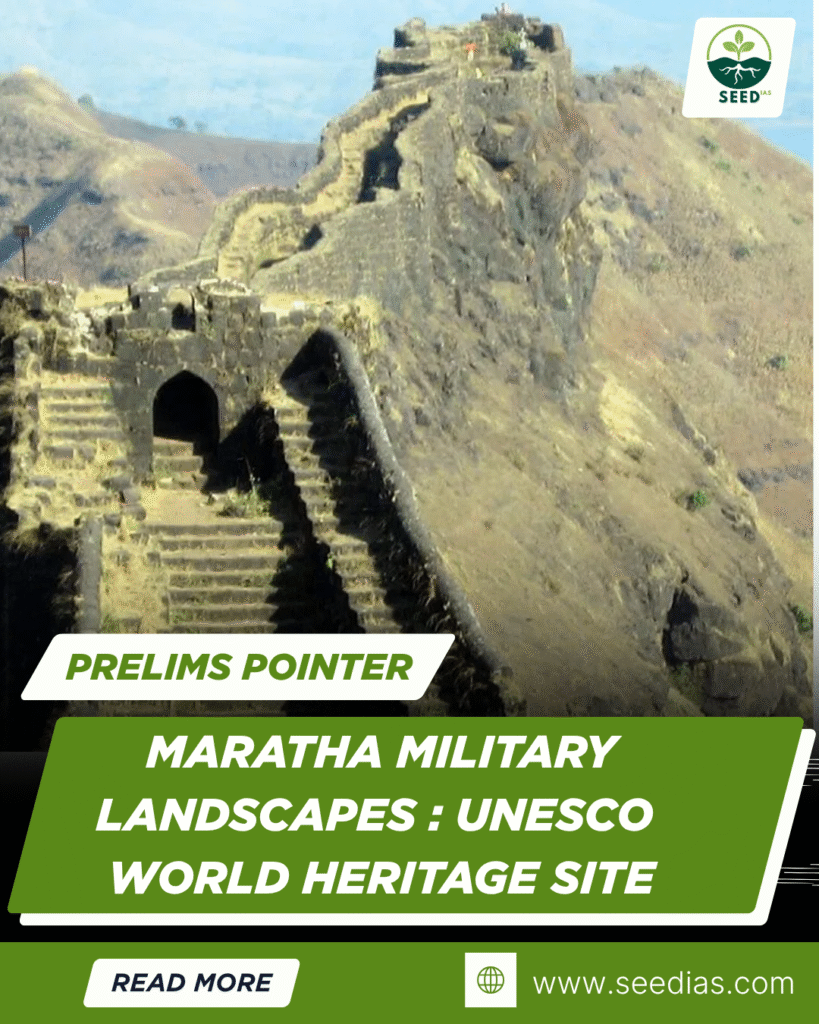Why in News?
At the 47th Session of the World Heritage Committee (WHC), India’s official nomination for the 2024–25 cycle, the Maratha Military Landscapes, has been inscribed on the UNESCO World Heritage List, making it India’s 44th World Heritage Site. This follows the inscription of the Moidams of Charaideo (Assam) in 2024.
Key Terms/Concepts
| Term | Explanation |
|---|---|
| UNESCO World Heritage Site | A landmark or area with legal protection by an international convention administered by UNESCO due to its cultural, historical, or natural significance. |
| Outstanding Universal Value (OUV) | Cultural or natural significance so exceptional that it transcends national boundaries and is of common importance for present and future generations. |
| Tentative List | An inventory of properties which a country intends to consider for nomination to the World Heritage List. |
| Criteria (iv) | A site that is an outstanding example of a type of building or architectural ensemble. |
| Criteria (vi) | A site directly associated with events, traditions, or beliefs of outstanding universal significance. |
What is the Maratha Military Landscape?
| Aspect | Details |
|---|---|
| About | The Maratha Military Landscapes consist of 12 forts built or expanded between the late 17th and early 19th centuries, reflecting the Maratha empire’s military and strategic prowess. |
| Location | 11 forts in Maharashtra, 1 in Tamil Nadu (Gingee Fort). |
| Strategic Importance | These forts were designed to dominate coastal routes, hill passes, and interior trade lines, ensuring territorial control and defense. |
| Period | Built during the rule of Chhatrapati Shivaji Maharaj and his successors. |
Classification by Terrain
| Terrain Type | Forts |
|---|---|
| Hill Forts | Salher, Shivneri, Lohgad, Raigad, Rajgad, Gingee |
| Hill-Forest Fort | Pratapgad |
| Hill-Plateau Fort | Panhala |
| Coastal Fort | Vijaydurg |
| Island Forts | Khanderi, Suvarnadurg, Sindhudurg |
Protection & Jurisdiction
| Agency | Forts Under Control |
|---|---|
| Archaeological Survey of India (ASI) | Shivneri, Lohgad, Raigad, Suvarnadurg, Panhala, Vijaydurg, Sindhudurg, Gingee |
| Maharashtra Directorate of Archaeology and Museums | Salher, Rajgad, Khanderi, Pratapgad |
UNESCO World Heritage Nomination Process
| Step | Details |
|---|---|
| Tentative Listing | India proposes sites it may nominate in future (currently 62 on India’s Tentative List). |
| Nomination | Only 1 site per year can be officially nominated by each State Party. |
| Evaluation Bodies | Cultural sites: ICOMOS; Natural sites: IUCN; Support: ICCROM. |
| Inscription Decision | Taken by the World Heritage Committee at its annual session. |
India and the World Heritage Convention
- India joined the 1972 World Heritage Convention in 1977.
- Currently holds 44 inscribed sites: 32 cultural, 7 natural, and 1 mixed.
- India is a member of the WHC for 2021–25.
- Ranks 6th globally and 2nd in Asia-Pacific for number of inscribed sites.
Selection Criteria for World Heritage Sites
| Unified Criteria (Since 2005) | Type |
|---|---|
| (i)–(vi) | Cultural Criteria |
| (vii)–(x) | Natural Criteria |
A site must meet at least one of the ten criteria and have Outstanding Universal Value (OUV).
Significance of the Maratha Military Landscapes
- Architectural Excellence: Combines local terrain adaptation, unique design, and advanced water harvesting systems.
- Cultural Value: Embodies Maratha military spirit and resilience.
- Historical Relevance: Linked to major events in Indian resistance against Mughal and colonial powers.
- Technological Significance: Use of natural barriers and materials adapted to diverse terrains.
In a Nutshell (Memory Aid)
M-A-R-A-T-H-A Forts
M – Maharashtra (majority located here)
A – Adapted to diverse terrains (hill, coast, island)
R – Raigad, Rajgad – iconic political centres
A – ASI & State protected sites
T – Terrain-based classification
H – Heritage recognition by UNESCO (Criteria iv and vi)
A – Architectural brilliance and strategic design
Prelims Practice Questions
Q1. With reference to the Maratha Military Landscape, consider the following statements:
- It includes forts from both Maharashtra and Karnataka.
- The nomination was accepted under UNESCO criteria (iv) and (vi).
- Only forts protected by ASI can be inscribed as World Heritage Sites.
Which of the above statements is/are correct?
A. 1 and 2 only
B. 2 only
C. 2 and 3 only
D. All of the above
Q2. Consider the following:
- IUCN
- ICCROM
- ICOMOS
Which of the above are advisory bodies under the UNESCO World Heritage Convention?
A. 1 and 2 only
B. 2 and 3 only
C. All of the above
D. 1 and 3 only
Q3. Which of the following is NOT a terrain classification under the Maratha Military Landscape?
A. Hill Fort
B. Plateau-Coastal Fort
C. Island Fort
D. Hill-Forest Fort
Mains Practice Questions
Q1. The inclusion of the Maratha Military Landscapes in the UNESCO World Heritage List highlights the evolving understanding of cultural heritage. Discuss its historical and architectural significance.
Q2. Explain the process of nominating a World Heritage Site and evaluate India’s performance in preserving its inscribed cultural heritage properties.
Answers Table
| Question | Correct Answer | Explanation |
|---|---|---|
| Q1 | B | Karnataka is not part of the nomination; non-ASI sites can be included. |
| Q2 | C | All three (IUCN, ICCROM, ICOMOS) are advisory bodies under the Convention. |
| Q3 | B | “Plateau-Coastal Fort” is not an official terrain classification. |
















